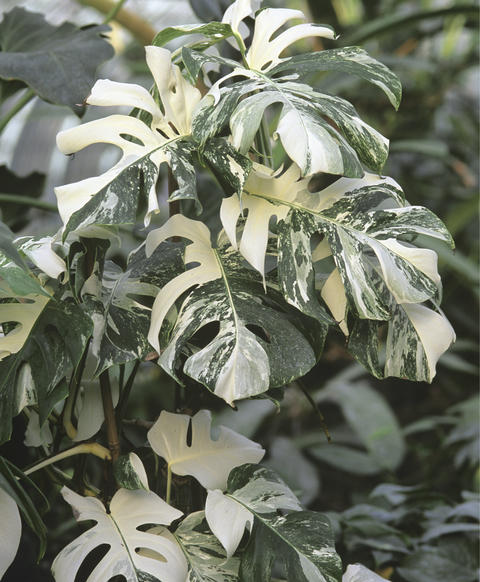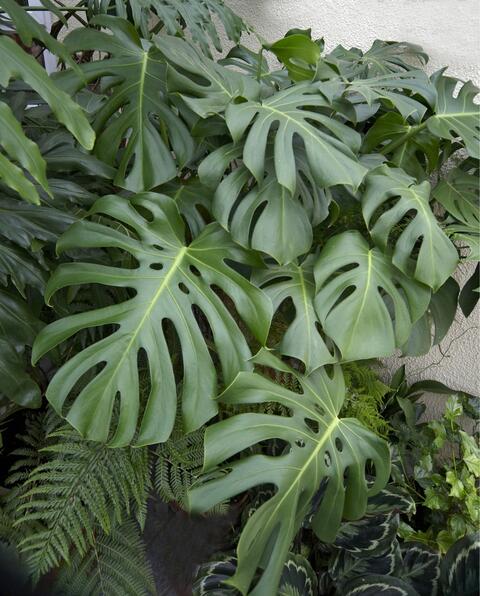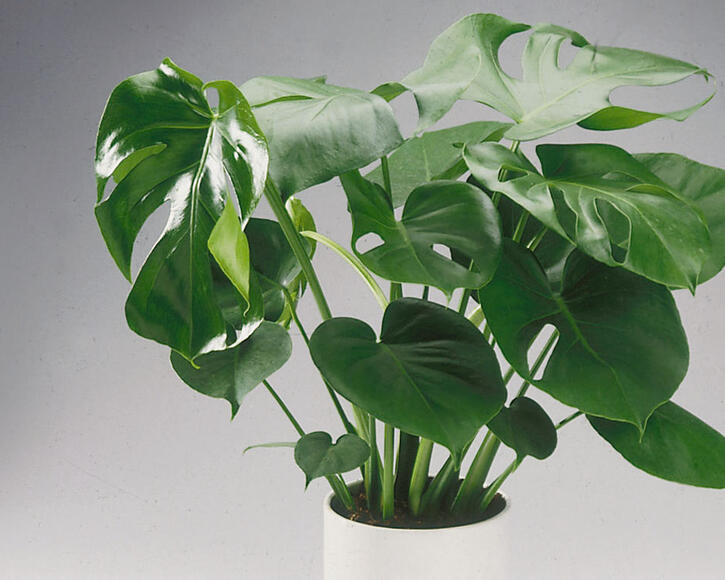Monstera, Swiss Cheese plant
The Monstera is considered a trendsetter among houseplants. The Swiss Cheese plant with its large, striking leaves, is not only present in homes, it has also provided decoration on wallpaper, posters and clothing for some years. The right way to care for Monstera.
Factsheet
- Growth type
-
- Climber
- Growth height (from)
- from 50 cm to 300 cm
- Growth characteristics
-
- Sling shoots
- Flower color
-
- white
- Flowering time (month)
-
- September to October
- Flower shape
-
- Pistons
- Spatha
- Flower characteristics
-
- unfilled
- hermaphroditic
- Leaf color
-
- green
- page format
-
- stalked
- heart-shaped
- deep slit
- pointed
- Sheet properties
-
- evergreen
- Light
-
- scattered light to shady
- Soil type
-
- sandy to loamy
- Soil Moisture
-
- moderately dry to moderately humid
- ph value
-
- neutral to weakly acidic
- Lime compatibility
-
- lime-tolerant
- Nutrient requirements
-
- moderately nutritious
- Humus
-
- rich in humus
- Decorative or utility value
-
- Leaf ornaments
- picturesque growth
- Toxicity
-
- partly poisonous
- Winter Hardness
-
- frost-sensitive
- Use
-
- Interior greening
- Climbing aids
- Planters
- Winter garden
- Warm House
- Garden style
-
- Pot garden
The Monstera, also known as a Swiss Cheese plant, originates from the forests of central and south America. In its tropical home, the ornamental leaf plant winds liana-like around tree trunks up to the crowns of the forest giants. The Monstera deliciosa is one of the most widely spread varieties. It has once again become fashionable as a houseplant for the past few years. Monstera prints decorate furnishings and posters. It has once again become fashionable and individual Monstera leaves stylishly decorate vases. The large-leaved plants with their conspicuous, slit leaves, draw everyone’s attention. Their easy-care has also contributed extensively to their popularity.
There are between 20 and 50 species of the genus Monstera, which vary in leaf-shape and growth. While some have deep, pinnatifid leaves, others are less extensively holey and form no or only a few aerial roots. Unlike most other Swiss Cheese species, the margins of the ‘Monkey Leaf’ Monstera remain closed, so they retain their holey appearance.
The Swiss Cheese plant grows upright and can reach up to ten feet high. The climber forms long, fleshy shoots which are not stable but can anchor inti rocky crevices and to other plants using their long, aerial roots and petioles. In their tropical home, this special climbing strategy enables them to use the tiniest humus deposit in a branch fork as a source of nutrients, because as soon as the aerial roots hit on moist, humus soil, they transform into normal roots.
The Monstera forms up to 20 inches long, peltate leaves which are initially light green and cordate with full margins, but which, over time, develop a shiny, dark green color. The characteristic, cheese hole shaped holes also form in the leaf surface, giving the leathery foliage a pinnate, lobate appearance. This makes the Monstera a decorative and impressive houseplant. It remains unclear as to why the plant forms such a special foliage. One explanation suggests that the large, slit-formed leaves improve light absorption in shady locations. The leaf stems of the Monstera are long, striking and strong. They are very firmly connected to the stem and often angled sharply downwards. This enables the Swiss Cheese plant to anchor itself onto the branches of other plants.

Older Monstera plants sometimes form a flower spadix surrounded by a large, white bract, typical for Araceae, on which violet berries later form. These are edible in principle, however they contain calcium oxalate needles which irritate the mouth and throat.
Monsteras require lots of space and are best planted in a large tub from the start. They prefer a light and warm (but not in full sunlight!) as well as relatively humid location in nutrient-rich substrate. They do tolerate semi-shady and shady locations - however, then the leaves do not form particularly well. They develop very beautifully if the light comes from several directions. The plant does particularly well in morning and evening light; it can also be placed in half-sunlight outside during the summer.
The room temperature should be around 70 degrees Fahrenheit in spring and summer. During the winter it can also be kept at lower temperatures between 60 and 65 degrees Fahrenheit.

Water Monstera regularly, but not too much. The plant tolerates dryness better than too much water. Waterlogging should be avoided at all costs. It tolerates stagnated water or a warm summer rain in its summer spot in the garden well. Spray your Monstera occasionally with room-temperature rain water or distilled water.
Our tip for when you are on vacation: If you are not able to water the houseplant for a while, dip the aerial roots in a glass filled with water. This guarantees a sufficient supply of liquid, even while you are away. The Monstera should be watered less from November to March.
Fertilize the Monstera every 14 days from April to August with liquid foliage plant fertilizer.
Younger Swiss Cheese plants should be re-potted annually as they grow very rapidly. Chose a larger container for this so that the fast-growing Monstera has enough place to further develop. For older plants, it is sufficient to replace the top 1.2 inches of soil with a fresh substrate in the spring.
Wipe the foliage occasionally with a damp cloth in order to remove dust deposits. This is particularly important at the end of the hot season. Are you considering whether perhaps because you don’t find them visually appealing? The answer is: No. You should actually do your best not to damage them when caring for the plant. You can simply redirect any aerial roots which are bothering you into the pot substrate, where they will quickly take root. If your Monstera is getting too big, you can shorten the fleshy stem at any time with secateurs. After some time, the plant will regrow from the leaf axil at the end of the stem.
The most common is the variety 'Borsigiana', whose leaves do not grow quite so large, but rather narrow and often less openwork. A variety with variegated leaves is Monstera 'Variegata'. It grows relatively slowly, is a bit more sensitive and requires much more heat. It should not be placed too dark, otherwise the leaves will turn green easily. If it forms shoots with only green leaves, you should cut them off early.
You can propagate Monstera in summer using head and stem cuttings. These form their own roots in a water container at around 77 degrees Fahrenheit. Take the cuttings in such a way that they have as many aerial roots as possible. It is also possible to layer the shoots, similarly to the way in which a rubber plant is propagated: For this, simply cut off an aerial root and cover the shoot cutting all around in a mixture of damp moss and potting soil which you then wrap securely with cling film in order to prevent it from drying out. When fine roots are visible under the film, you can simply cut off the shoot segment and plant it.
Monstera are easy-care and robust houseplants which only rarely suffer from disease. They occasionally suffer from scaly insects and spider mites. Brown margins and tears indicate that the plant is being kept in an environment which is too cool and damp. Yellow foliage is also a sign that the root ball is too damp. If there is no foliage division, the plant is probably not getting enough sunlight, or it has a nutrient deficiency.

